Francis Willughby, Ornithology (London, 1676)
The Ornithologiæ libri tres (referred to as the Ornithology) is one of the first truly scientific ornithological texts. The original Latin version was published in 1676 with an enlarged and corrected English version following in 1678. It was published four years after the death of Francis Willughby (1635–1672) by his friend and collaborator John Ray (1627–1705). These two natural historians had met at Trinity College Cambridge in the 1650s and spent time travelling around Britain and Europe collecting and observing nature.
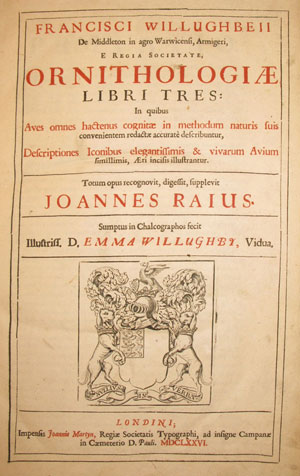
Previous works concerning birds typically contained information gleaned from earlier sources such as Aristotle and Pliny with extra comments by the author. These works would usually describe the birds, where they might be found, whether they were edible, if they had any medicinal value, and what their human traits and characteristics were (for example Wrens are viewed as brave while Finches are dim-witted). It was also not uncommon to find mythical and fabled birds such as the phoenix and griffin amongst the pages of such works. As the study of natural history progressed the standards of ornithological works improved but they still lacked sensible and coherent organisation. Birds tended to be grouped together by habitat and then by their actions. Walter Charleton's (1619–1707) system, explained in his Onomasticon zoicon (London, 1668), involved looking at the birds' diets, whether they bathed (and in what water/sand) or sang. The way birds were ordered changed with the publication of the Ornithology. Firstly, they are classed here as land or water birds. The land birds are then divided into those with crooked beaks and claws and then those with straight beaks. The water birds are divided into those 'that wade in the waters, or frequent watery places, but swim not; The second, such as are of a middle nature between swimmers and waders, or rather that partake of both kinds, some whereof are cloven-footed, and yet swim; others whole-footed, but yet very long-leg'd like the waders: The third is of whole-footed, or fin-toed Birds, that swim in the water'. This is thought to be the first attempt to rationally classify birds.
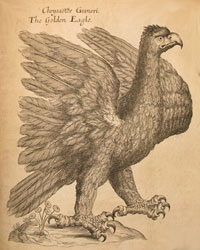
Debates about whether Willughby or Ray should be seen as the more substantial partner of the work have arisen over the centuries. According to Charles Raven during the mid-nineteenth century, when the Ray Society was being founded, a group of scientists thought that Willughby's part in the Ornithology was under attack. Raven believed that these scientists overstated the role of Willughby after reading comments made by the eighteenth-century English botanist James Edward Smith. One of these scientists was Neville Wood who in 1836 wrote that the credit for the system used in the Ornithology was being wrongly attributed to Ray and stated that '..whatever he might be in Botany, [Ray] had very little merit as an Ornithologist'. Wood's contemporary William Swainson agreed stating that Ray's talent lay more in botany while Willughby's was in zoology. Peter Bircham has recently argued that Raven (who saw Ray as a scientific genius and 'generous to a fault' while viewing Willughby as an amateur) came across the words of Swainson and felt the need to defend his subject. Bircham concludes that Raven bases his view of Willughby on his '...assessment of Ray [rather] than on any tangible evidence or knowledge of Willughby' and that Willughby was, as Swainson claims, as good a zoologist as Ray was a botanist.
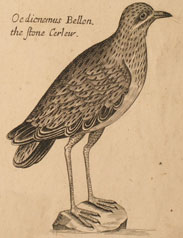
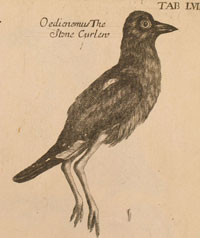 The 77 illustrations contained in the Ornithology come from various sources. Some are copies made from the collection of pictures and specimens owned by Willughby, others Ray had commissioned. The quality of the illustrations varies greatly; some are very lifelike and easily identified while others are not. Many of the birds have unusual postures for their species while those drawn from specimens (dead or alive) tend to be the more accurate. Ray himself puts the lack of quality down to the fact that he was unable to fully oversee the engravers' work as he was away from London and had to send instructions by letter. Some birds are included twice as the first engraving was seen as inadequate. For example both TAB.LVIII and TAB.LXXVII contain depictions of the Stone Curlew. The first engraving looks to be drawn from a dead specimen, while the second is more recognisable as the bird it is supposed to represent owing to its more detailed plumage and the identifiable stripe on the head.
The 77 illustrations contained in the Ornithology come from various sources. Some are copies made from the collection of pictures and specimens owned by Willughby, others Ray had commissioned. The quality of the illustrations varies greatly; some are very lifelike and easily identified while others are not. Many of the birds have unusual postures for their species while those drawn from specimens (dead or alive) tend to be the more accurate. Ray himself puts the lack of quality down to the fact that he was unable to fully oversee the engravers' work as he was away from London and had to send instructions by letter. Some birds are included twice as the first engraving was seen as inadequate. For example both TAB.LVIII and TAB.LXXVII contain depictions of the Stone Curlew. The first engraving looks to be drawn from a dead specimen, while the second is more recognisable as the bird it is supposed to represent owing to its more detailed plumage and the identifiable stripe on the head.
These two plates have been hand coloured by an unknown person and are the only ones to contain colour in the Whipple's copy of the Ornithology. A hand-coloured English version of the Ornithology was apparently given to Samuel Pepys between 1684 and 1686 when he was president of the Royal Society (see bibliography).
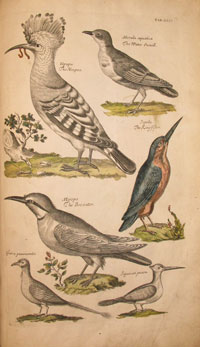
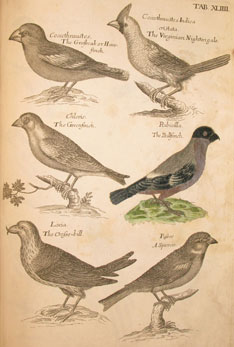
TAB.XXIV TAB.XLIII
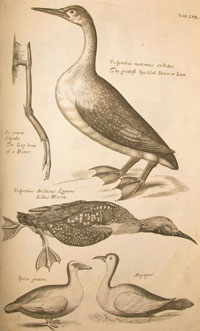
The illustrations credited to Thomas Browne (1605–1682) are of the best quality. These are thought to include the illustrations of the Shearwater, Little Auk, Razorbill, and Great Northern Diver. Some of the illustrations in the Ornithology are of the anatomy of the birds, for example the plate on the left includes a leg bone of a Diver.
Another example of a bird appearing twice is the Sheldrake (middle bird in each plate). In the first engraving the tell-tale band on its upper parts is missing while it is quite visible on the second. The description of this bird in the Ornithology states: 'The upper part of the breast and the shoulders are of a very fair orange or bright bay-colour. [The fore-part of the body is encompassed with a broad ring or swarth of this colour].'
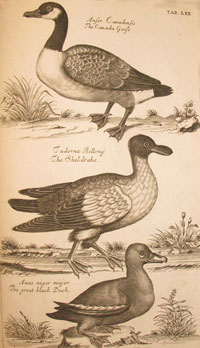
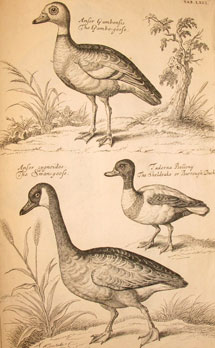
TAB.LXX TAB.LXXI
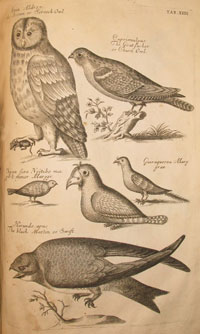
This plate shows the 'Caprimulgus, The Goatsucker or Churn Owl' (top right), now known as the Nightjar. It was thought that this bird went in to stables at night to suck the milk from goats, causing them to go blind. The Nightjar is a very well camouflaged nocturnal bird with owl-like plumage. This plate also shows a recognisable Black Martin or Swift and a very strange and unknown bird in the centre.
Bibliography
- Albert the Great (Translated by J.J. Scanlan). Man and the beasts: de animalibus (books 22–26) (Medieval & Renaissance Texts & Studies, 1987)
- Bircham, P. A history of Ornithology (Collins, 2007)
- Birkhead, T. The wisdom of birds (Bloomsbury, 2008)
- Farber, P.L. Discovering birds (Johns Hopkins University Press, 1997)
- Haffer, J. 'The development of ornithology in central Europe', Journal of Ornithology 148, suppl. 1, (2007) pp.125–153
- Jardine, W. The natural history of the Nectariniadae, or sun-birds (W.H. Lizars, 1843)
- Miall, L.C. Early naturalists (Macmillan, 1912)
- Montgomerie, R. & Birckhead, T.R. 'Samuel Pepys's hand-coloured copy of John Ray's "The Ornithology of Francis Willughby" (1678)', Journal of Ornithology 150 (2009) pp.883–891
- Raven, C.E. John Ray (Cambridge University Press, 1950)
- Ray, J. & Willughby, F. The ornithology of Francis Willughby of Middleton... (Printed by A.C. for John Martyn, 1678)
- Smith, J.E. 'Introductory discourse on the rise and progress of natural history', Transactions of the Linnean Society of London 1 (1791) pp.1–55
- Stresemann, E. Ornithology from Aristotle to the present (Harvard, 1975)
- Welch, M.A. 'Francis Willoughby, F.R.S. (1635–1672)', Journal of the Society for the Bibliography of Natural History 6 (1872) pp.71–85
- Wood, N. Ornithologist's Text-Book (John W. Parker, 1836)
Dawn Moutrey
